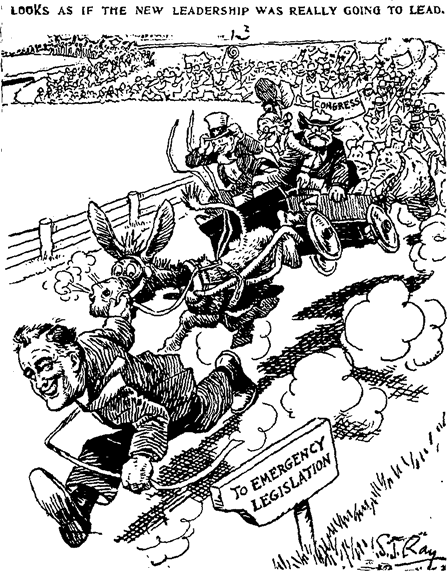This Week in History:
June 12 - 18, 1933
A Review of FDR's First Hundred Days
June 2011
|
|
June 16, 1933 was the conclusion of what has come down in American history as the First Hundred Days of the Administration of Franklin Delano Roosevelt. Congress finished its work on June 15, and the President signed the final pieces of legislation on the 16th.
A review of what that period meant, can best be understood by contrasting it with the process that was going on in Nazi Germany at the same time, when Adolf Hitler was moving rapidly to consolidate total dictatorial power over the state. The conceptions of policy and leadership could not have been more different. And it was only because FDR resisted the powerful bankers who had helped put Hitler into power, that the United States did not also succumb to fascism, but instead went on the path to restoring our Constitutional commitment to the general welfare principle.
What FDR accomplished in the push for emergency legislation during the Hundred Days, was a mixture of stopgap measures, re-regulation efforts, and essential boosts to the physical economy, through programs of infrastructure construction and public-works employment. Perhaps the only actual model which was passed, was the Tennessee Valley Authority Act, a major project that transformed that seven-state river valley from a Third World-like center of devastation, to a thriving, modern agro-industrial hub. Many of the other measures went in the right direction, in using Federal government power to enforce the general welfare, but would have to be adapted to different conditions today.
 Kansas City Star/S.J. Ray President Roosevelt’s push for Glass-Steagall and other crucial legislation, during the first 100 days of his Presidency, brought the Constitution’s founding principles to bear to solve the emergency facing the nation.. |
The "energy" of the Federal government, which Alexander Hamilton fought so hard to institutionalize in our Constitution, was one of the major characteristics of this period. In these first three months, the President sent 15 messages to Congress, guided 15 major laws through Congress, delivered 10 speeches, constantly consulted with advisers and heads of state, and took personal responsibility for thousands of decisions in domestic and foreign policy.
In addition, he initiated a direct form of communication with the public through what became known as the "Fireside Chat," an intimate direct address to the formerly "forgotten men and women" of America over the radio, to explain the measures he was taking, and why. FDR gave two of those "chats" during the Hundred Days period, out of eight which he gave during his first term in office. By the nearly universal testimony of contemporaries, these chats conveyed to the American population a sense of confidence in leadership, and increasingly, in themselves, that was critical to getting the nation out of the Depression.
The following are the landmark pieces of legislation passed, with small descriptions of their impact, or significance:
March 9—The Emergency Banking Act, which established crucial Federal regulatory powers over the bankrupt banking system, permitting its recovery.
March 20—The Economy Act, which mandated budget cuts that the Democratic Party platform had promised, but ranged from useless to counterproductive, in terms of restoring the economy.
March 31—Civilian Conservation Corps established—this had both short-term and long-term benefits in employment and land-management projects.
April 19—The gold standard (British) was abandoned, a positive move toward restoring U.S. national sovereignty.
May 12—The Federal Emergency Relief Act, a stopgap measure which supported state welfare payments, and created some public works jobs.
May 12—The Agricultural Adjustment Act, with an amendment permitting monetary expansion. This bill was misguided in its attempt to curtail production, as a means of accomplishing the legitimate aim of raising farm prices.
May 12—The Emergency Farm Mortgage Act, which played a crucial role in preventing mass farm evictions.
May 18—The Tennessee Valley Authority Act, a model for Federal-state cooperation in building crucial infrastructure projects in the areas of providing water and power.
May 27—The Truth-in-Securities Act, which took the first steps toward regulation of the Wall Street market.
June 5—The Gold Standard Act, which gave the Federal government even more control over the nation's currency and credit system.
June 13—The Home Owners' Loan Act, which provided for the refinancing of mortgages for those facing foreclosure, and ultimately benefitted one out of every five urban home-mortgage holders.
June 16—The Glass-Steagall Banking Act
June 16—The National Industrial Recovery Act. This act had three provisions: 1) declare a national emergency permitting suspension of anti-trust laws, in order to regulate production. This included a subsidiary provision permitting the "right to organize"; 2) establish the Works Progress Administration; and 3) provide for funding of the Works Progress Administration.
June 16—The Farm Credit Act. This act provided credit for expanded and refinanced farm mortgages.
June 16—The Railroad Coordination Act.
With a committed leader in the Presidency, devoted to the general welfare, you can see that Congress indeed can be made to move to deal with an emergency. If it could happen then, it can happen again today.
The original article was published in the EIR Online’s Electronic Intelligence Weekly, as part of an ongoing series on history, with a special emphasis on American history. We are reprinting and updating these articles now to assist our readers in understanding of the American System of Economy.

